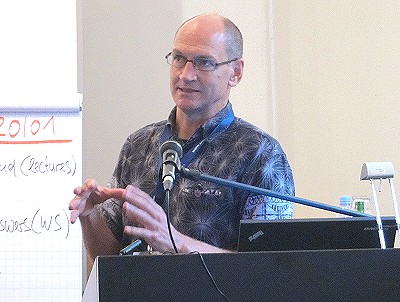An interesting example of successful science engagement in the Pacific
Dr Hugh Govan reported on experience with implementing a relatively novel strategy of supporting community resource management in small island developing states in the Pacific. Coastal and off-shore fisheries are of great importance to island economies. In decreasing order they matter for nutrition and food security, for GDP and for government revenue. Overexploitation of commercial invertebrate fisheries are causes for concern, particularly in populous Melanesia (close to 9 million people). Think e.g. of moratoria now in place for sea cucumbers (bêche-de-mer). Four out of five communities are expected to fall short of their needs by 2030 if current trends continue unabated. Communities are predominantly rural. Yet, most development money went into offshore fishing, which contributes little to the national economy. But offshore fishing by foreigners generates much of the government's income other than aid, even if the licencing captures only a small fraction of the resource value. Given the, at best modest, ability of governments to ensure services and management of their vast distributed territories, community based management is the most realistic option.
 Recognising this reality was the first step towards supporting communities through promoting coastal resource management, learning what works and why, building capacity and developing favourable policies. In order to take well-targeted action, the network members determined that decision makers were mostly fishers and their communities rather than administrations in the capital city. These communities view the inshore fisheries predominantly through the lense of livelihoods and local problem solving in the community. The most useful type of information for them integrated existing marine and land tenure practices into consensus-building around a adaptive local fisheries management plan. The plans revolved around zoning and gear and access restrictions, among others, rather than a blanket closure which might have been impossible to enforce. Each community assessed where the biggest challenges were, what options they had and then built social consensus around adoption and enforcement. The final step in the cycle was to check whether it was working or in need of adjustments.
Recognising this reality was the first step towards supporting communities through promoting coastal resource management, learning what works and why, building capacity and developing favourable policies. In order to take well-targeted action, the network members determined that decision makers were mostly fishers and their communities rather than administrations in the capital city. These communities view the inshore fisheries predominantly through the lense of livelihoods and local problem solving in the community. The most useful type of information for them integrated existing marine and land tenure practices into consensus-building around a adaptive local fisheries management plan. The plans revolved around zoning and gear and access restrictions, among others, rather than a blanket closure which might have been impossible to enforce. Each community assessed where the biggest challenges were, what options they had and then built social consensus around adoption and enforcement. The final step in the cycle was to check whether it was working or in need of adjustments.
True to honouring local traditions, such local community management plans get endorsement through a sacrifical pig and the declaration of a tabu rather than the signing of a formal contract. Rapid uptake from a few to more than 600 in a short time-span is believed to be in no small manner helped by exactly that respect and modernisation of deep rooted traditions. A non-sectoral approach is also suited to serve multiple purposes in a community and make use of opportunities afforded by at least some project support. The concepts even expanded into the Western Indian Ocean and new places in the Pacific, including to communities where project and science support was not available. Very few have any formal legal basis.
Huge challenges remain all the same as the number of communities in the Pacific is estimated to be in the order of 10,000 and it is difficult to conceive that governments could provide a costly information and support service to each and everyone of them even though at national and regional levels community-based co-management is the official policy discourse. It is thus worth reflecting on how research, provision of information and other support to community management can be expanded in an ever more cost effective way, including perhaps through social media and distance training. As personnel and travel costs are the biggest budget positions in supporting management, joining forces e.g. with agricultural extension services, disaster relief and others are also promising avenues for delivery of support. The Secretariat of the Pacific Community (SPC) has already produced some fact sheets for key species and ecosystem features and other information material ready for use. Hugh's powerpoint presentation can be downloaded here.








